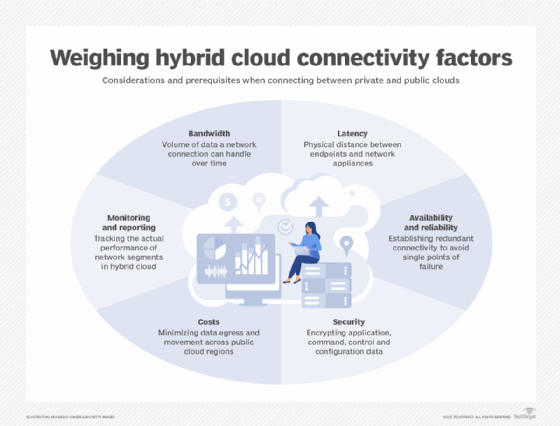Top 8 benefits of hybrid cloud for business

Businesses are migrating workloads to the public cloud and implementing private clouds in-house. As these forms of cloud computing continue to expand, large and small businesses are focused on a hybrid cloud strategy to bridge the two models and form a hybrid cloud environment.
What is hybrid cloud?
A hybrid cloud is a logical construct that establishes an operational connection between a private cloud and public cloud. The private cloud is typically built and operated by the individual business and intended solely for the benefit of the business. It might be implemented within the local data center or provided as a third-party service. A public cloud is typically a major multi-tenant cloud provider such as Amazon Web Services (AWS), Microsoft Azure or Google Cloud as well as numerous other SaaS providers. A hybrid cloud exists when a relationship is established between the public and private cloud to create a single, ubiquitous, logical cloud entity.
In more practical terms, a hybrid cloud is an amalgamation of technologies that include an on-premises data center, in-house or third-party private cloud and public cloud services. These various technologies are connected through a WAN and integrated through orchestration techniques to move workloads seamlessly between private infrastructure and public clouds as computing needs or cost models change. Ideally, a hybrid cloud provides businesses with competitive advantages like greater flexibility and alternatives for workload deployment without unwanted tradeoffs, such as migrating traditional VM workloads to cloud instances or developing cloud-native applications tied to a specific provider’s services.
Hybrid clouds can be challenging to build and maintain. Enterprises have no direct control over the public cloud, so they must architect a private cloud to be compatible with the intended public cloud or multiple clouds. Compatibility includes suitable compute, storage and networking hardware, along with compatible virtualization and private infrastructure software such as OpenStack, to provide a desired array of private cloud services, network services, enterprise workloads and so on. This setup requires the substantial expertise of enterprise cloud architects and engineers.
The most critical consideration is implementing a private cloud software stack compatible with the target public cloud’s APIs and services. Without this compatibility, workloads and data can’t move seamlessly from private to public clouds and back.
What are the benefits of a hybrid cloud?
Even though there’s considerable investment and effort involved, eight main hybrid cloud benefits make it worthwhile for enterprises.
1. Cost control
A business must be prudent about the workloads and services that run in its private infrastructure. A private cloud is typically deployed with an on-premises data center infrastructure that the enterprise controls and operates, requiring a significant investment of capital, equipment and talent to deploy and maintain. Although a private cloud can parse and provision local resources in a cloudlike manner, the private cloud infrastructure is still finite.
An enterprise can mitigate costs with a connection between its private cloud and a public cloud. When local demand stresses capacity, the business draws upon additional resources of the public cloud to help smooth those spikes in demand. Similarly, the public cloud suits temporary, experimental or general-purpose workloads the company doesn’t want to source, set up and manage in-house, such as disaster recovery. It’s best to use finite private cloud resources for critical workloads and data or simply run workloads where the costs are lowest.
Public cloud resources and services can also reduce hardware costs within an on-premises data center. For example, a business that uses a server within a public cloud doesn’t purchase or maintain that server locally.
The cost benefits of hybrid cloud also provide clarity about where the money goes. A hybrid cloud can make it easy to divide IT consumption into capital and operational costs. Enterprises can use tools and practices such as FinOps to monitor cloud usage and obtain detailed reports on utilization by department, manager, workload or other criteria and quantify the costs of cloud services.
2. Flexibility and scalability
Agility is a core premise of cloud computing. A private cloud provides some provisioning and scaling agility, but the amount of available resources in a physical data center is still limited by the individual organization’s budget and capabilities. In contrast, public cloud users can immediately deploy compute and storage instances as well as related services without constraints on resources. But expect at least some migration preparation work to move a local workload from private infrastructure to the public cloud or from a public cloud back to the private cloud.
Consistency is one of the main hybrid cloud benefits. It’s easier to create, shift and scale workloads and resources if the private cloud offers instance types and services similar to those available in the chosen public cloud. This consistency enables enterprises to provision and use private cloud resources when it’s appropriate and cost-effective, then easily draw upon additional resources from the public cloud when necessary.
3. Security
Security is a core focus for many enterprise IT teams. Data and the workloads that access it are vital business assets. A main security concern with public cloud is that the infrastructure is the exclusive property of the cloud provider, and the public cloud infrastructure is typically shared among varied users (multi-tenant). The cloud user can’t see or control the entire cloud infrastructure. Additionally, the cloud provider takes on responsibilities to secure users’ environments in the cloud but is rarely responsible when a breach or other malicious activity occurs. Security responsibilities are shared between cloud users and providers.
In many cases, the best way to protect data is to keep it on premises. The most sensitive data and critical workloads stay within the owned data center on a private infrastructure where the organization’s IT staff maintains and safeguards the assets. With a combined public and private environment, enterprises gain some common hybrid cloud oversight. Best practices and tools such as Trend Micro Deep Security, McAfee hybrid cloud security products and IBM hybrid cloud infrastructure can help organizations monitor, discover and report security issues across the hybrid cloud environments.
4. Compliance
One advantage of public cloud is its global reach and abundant nature. Ideally, networking, storage and computing technologies support most workload operations from data centers located almost anywhere, even at the network edge. It should not matter where a workload resides in the public cloud provider’s fleet of data centers. But geopolitical boundaries can come into play, with regulatory limitations on where companies store data (a concept called data sovereignty) and operate computing workloads. That complicates the move to purely public cloud for some multinational organizations.
With a hybrid cloud, a business can operate sensitive workloads in its private cloud and move data to and from suitable data centers across the public cloud as the regulatory landscape changes or as data and workloads evolve. In a big data processing project, for example, a company can collect personally identifiable customer data in a private cloud, sanitize it in-house and send it to a public cloud application for processing or analysis.
5. Uniformity
Hybrid clouds, in theory, support greater standardization in IT management practices. But in practice, organizations often struggle to create that uniformity. IT staff doesn’t want to assemble and operate a private infrastructure framework, then develop workflows and cobble together services that are hopefully consistent enough with a public cloud provider to make the hybrid setup work. That’s a time-consuming, error-prone and expensive endeavor.
Public cloud providers have become more sensitive to the importance and benefits of hybrid cloud as well as the challenges to integrate private and public environments. Top cloud providers offer various services that focus on hybrid needs:
- Microsoft Azure Stack enables a business to deploy Azure capabilities in on-premises systems.
- AWS Outposts offers capabilities for a hybrid cloud setup based on AWS services.
- Google Anthos doesn’t directly extend Google Cloud Platform services on premises; it uses Kubernetes, containers and plugins to deploy services and workloads in different locations.
- VMware Cloud on AWS is a partnership designed so users can integrate their on-premises VMware environments with Amazon’s cloud.
These offerings provide pre-packaged hardware and software stacks that can be easily deployed within the users’ data center to create a private cloud that’s already interoperable with the providers’ broader public cloud platform. A business saves considerable time, expertise and investment. As public cloud providers embrace hybrid cloud management, businesses don’t need to construct a complete environment top to bottom. Instead, they simply extend the virtualized data center into familiar services in the cloud.
6. Agility
Clouds are designed to make provisioning and scaling much faster than traditional physical or virtualized environments. This “on-demand” agility played a huge role in public cloud adoption. Private clouds seek to replicate this kind of behavior. When public and private clouds are merged into a hybrid cloud, that speed and agility takes on an entirely new meaning. Businesses can stand up new workloads and data sets on demand and make strategic choices about where those resources should be deployed depending on factors like cost, scale and performance.
A business deploying an application in the private cloud, for example, could scale up the application by deploying a second iteration of the workload in a public cloud data center located within a different geopolitical area that can provide better performance for local users while maintaining data sovereignty requirements. Such goals are almost impossible with traditional data centers and workloads.
7. Continuity
Business continuity — the ability to continue functioning during disruption — is often a primary element of regulatory compliance. Another way that a hybrid cloud enhances business continuity is to support application, data and disaster recovery tasks to protect against system failures, security issues and physical disasters.
A business, for instance, could replicate a critical workload’s data from a local application to a public cloud, ensuring that the data remains available or can be restored in the event of data loss at the application. In a more sophisticated example, a business might scale or migrate a busy application from its private cloud to the public cloud to accommodate a spike in user traffic. Such tactics are ideally suited to hybrid cloud environments, and they can avert workload performance problems and disruptions, further improving user experience.
8. Risk management
All enterprise applications and data resources carry some element of risk in terms of security, performance and reliability. Hybrid clouds give businesses the control and agility needed to seamlessly locate applications and data according to changing business and technology needs.
A hybrid cloud lets an enterprise decide where to locate the application and data as well as how to best provision the required resources and services to create the most desirable outcome for the business and its application users.
What are the disadvantages of a hybrid cloud?
Although the potential hybrid cloud benefits can be compelling, numerous hybrid cloud disadvantages need to be considered, mainly related to complexity issues.
Architectural complexity
Designing and implementing a hybrid cloud is a detailed undertaking and often requires the service of a skilled cloud architect. While the underlying servers, storage and networking hardware can be relatively straightforward, the private infrastructure software stack can be complicated to master. Cloud architects must build resources and services within that private tech stack and understand the intended public cloud so resources and services align and interoperate. That raises the bar for change management and software stack patches and upgrades.
Ultimately, the key to a successful hybrid cloud is interoperability. A private cloud often must operate in the same ways as its associated public cloud to ensure seamless operation. If a business, for example, chooses to build a private cloud to interoperate with a public cloud such as AWS, the private cloud must possess some level of compatibility with AWS and its services. As a result, private clouds might be forced to make software and architectural choices that could be difficult or sub-optimal for the business. Packaged private clouds such as AWS Outposts ease these challenges but lock the business further into the provider’s architecture.
Security complexity
Hybrid clouds can be strikingly difficult to configure and secure. IT staff must implement and manage not only authentication and security for private, or local, workloads and data but also comprehensive authentication and access control for public, or global, cloud resources and services. Security settings for the two realms must remain consistent and complementary, and a change in one cloud might need to be reflected in the other. Oversights or errors can expose vital data and critical workloads to unauthorized access and loss.
Clear security policies and practices will help by defining security settings and standards. Automation can be an essential tool in deploying and enforcing security policies to avoid oversights and human error. Still, security impacts regulatory compliance and requires comprehensive knowledge of private and public cloud architectures to implement and test thoroughly.
Troubleshooting complexity
Problems in a hybrid cloud environment can be troublesome to isolate and mitigate. Administrators rely on detailed logs and tools to identify problems, and the troubleshooting process can vary between private systems and public clouds depending on where the trouble occurs. Efficient troubleshooting can require the services of highly experienced administrators and cloud engineers. For example, a private cloud offers complete visibility into the private infrastructure and software stack, while a public cloud only offers the visibility and control that’s supported by native providers’ and third-party tools.
Tools matter. Effective troubleshooting across a hybrid cloud demands well-integrated tools that ideally support a single pane of glass approach to enable observability and reporting with actionable alerting no matter where the issue occurs.

Hybrid cloud considerations
Enterprises can adopt several tactics to help mitigate the disadvantages of a hybrid cloud and enhance the success of any hybrid cloud project.
Understand security
The team responsible for implementing and managing a hybrid cloud environment should master cloud configuration and security. Invest in the training and expertise to secure the private infrastructure as well as the intended public cloud. Those configurations must work together seamlessly, but the knowledge base to accomplish that can’t be gleaned overnight. Some organizations spend considerable time and effort to experiment, develop and refine proof-of-principle deployments before they architect a deployment for production. Companies also should carefully document and manage security to maintain business and regulatory compliance.
Use encryption
Data is an organization’s most valuable asset. Encrypting that data at rest and in flight can help mitigate loss or theft when intruders manage to slip past a security vulnerability. Comprehensive encryption should be standard practice within private cloud and public cloud storage.
Move workloads with care
Hybrid clouds’ flexibility doesn’t eliminate the need for strategic decisions about workload deployment. Not all workloads are appropriate for each cloud type. Business and regulatory concerns might demand that some critical workloads remain in a local data center, while other workload types might be suitable or ideal for public cloud deployment. Organizations must understand where that line is for their own business and industry and make deployment decisions accordingly.
Similarly, not all workloads are suited for any cloud, and the costs of moving data sets from the public cloud can quickly become prohibitive. Legacy workloads might still require more traditional local data center infrastructure and management. IT staff must allow for private cloud and traditional data center infrastructure operating simultaneously.
Use automation and orchestration
Clouds are not intended to be manually controlled entities. Private infrastructure, public clouds and the hybrid clouds created from them depend on substantial automation to implement services and resources as uniform and consistent processes. Automation is matched with orchestration that carries out the automated tasks with little, if any, human intervention. For example, clouds are frequently based on container technologies and platforms such as Docker and Kubernetes.
Implement monitoring and observability
The adage “you can’t manage what you can’t see” is particularly true for hybrid clouds. Organizations depend on a variety of tools within the private cloud and tools supporting the desired public cloud provider to achieve observability across the entire hybrid cloud environment. Comprehensive monitoring is crucial to ensure workload availability, health and reliability as well as gauge performance no matter where those assets are deployed. Monitoring and observability provide a sound justification for scaling — adjusting the costly resources allocated to the workload — and offer objective measures for troubleshooting when problems arise.
Stephen J. Bigelow, senior technology editor at TechTarget, has more than 20 years of technical writing experience in the PC and technology industry.


